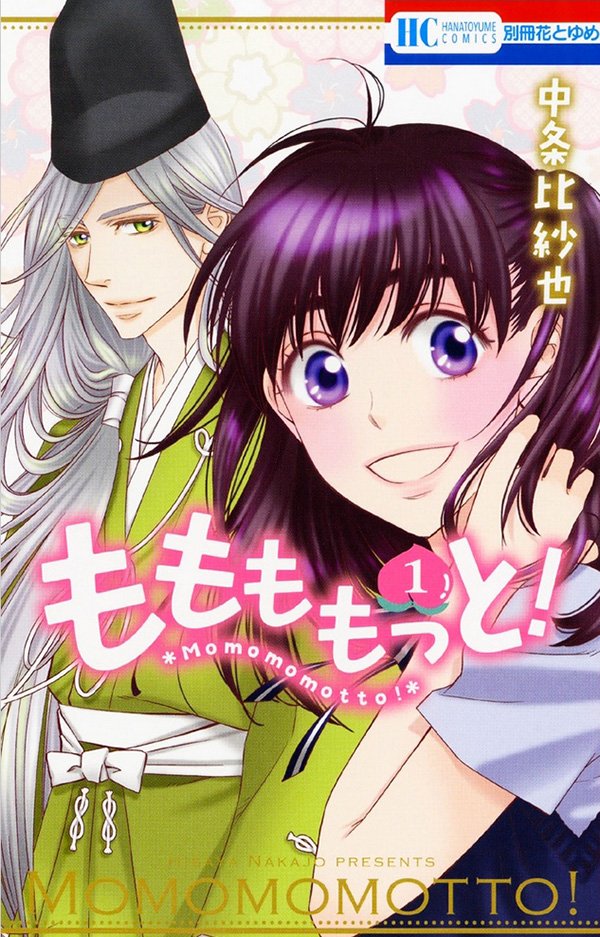 Our last review discussed the return of a widely loved Hana to Yume series featuring a clan and a curse forcing them to transform into animals when touched or stressed. Today this theme gets turned on its head as we witness the comeback of another Hana to Yume veteran, with a series featuring a hedgehog turning into a handsome young man! Following Takaya Natsuki and her Fruits Basket revival with Fruits Basket another, another big name formerly associated with Hakusensha’s semi-monthly Hana to Yume has moved to its monthly sister magazine, Bessatsu Hana to Yume (BetsuHana) with a new series: NakajÅ Hisaya who enjoyed immense popularity with her Hanazakari no Kimitachi e (Hana-Kimi – For You in Full Blossom) series which ran from 1996 to 2004, its start and end preceding Fruits Basket by 2 years respectively. Both series were long-running mega hits, the latter (Furuba) also receiving a TV anime series while the former (Hana-Kimi) was adapted into a successful TV drama series (2 seasons, 2007, 2011; a Chinese TV adaptation aired before them in 2006), a Korean drama version titled To The Beautiful You (Areumdaun Geudaeege) in 2012 and finally a dating game app in 2017.
Our last review discussed the return of a widely loved Hana to Yume series featuring a clan and a curse forcing them to transform into animals when touched or stressed. Today this theme gets turned on its head as we witness the comeback of another Hana to Yume veteran, with a series featuring a hedgehog turning into a handsome young man! Following Takaya Natsuki and her Fruits Basket revival with Fruits Basket another, another big name formerly associated with Hakusensha’s semi-monthly Hana to Yume has moved to its monthly sister magazine, Bessatsu Hana to Yume (BetsuHana) with a new series: NakajÅ Hisaya who enjoyed immense popularity with her Hanazakari no Kimitachi e (Hana-Kimi – For You in Full Blossom) series which ran from 1996 to 2004, its start and end preceding Fruits Basket by 2 years respectively. Both series were long-running mega hits, the latter (Furuba) also receiving a TV anime series while the former (Hana-Kimi) was adapted into a successful TV drama series (2 seasons, 2007, 2011; a Chinese TV adaptation aired before them in 2006), a Korean drama version titled To The Beautiful You (Areumdaun Geudaeege) in 2012 and finally a dating game app in 2017.
Hana-Kimi, a manga following the girl Mizuki who disguises herself as a boy to attend an all-boys school practically bursting with handsome, charismatic young men (ikemen), was collected into 23 tankÅbon volumes and a 2-volume collection of spin-off short stories subtitled After School. NakajÅ was unable to repeat the series’ million-selling success, though. Her short and sweet Sugar Princess (2 volumes) had difficulties during its run in Hana to Yume from 2005-2007, including being put on hiatus due to the artist’s health-related issues. One can only try to imagine how much more attention this series centering on a school girl’s passion for ice skating would have received if it had been released a decade later with the Yuri on Ice craze in full bloom (pun not entirely unintended).
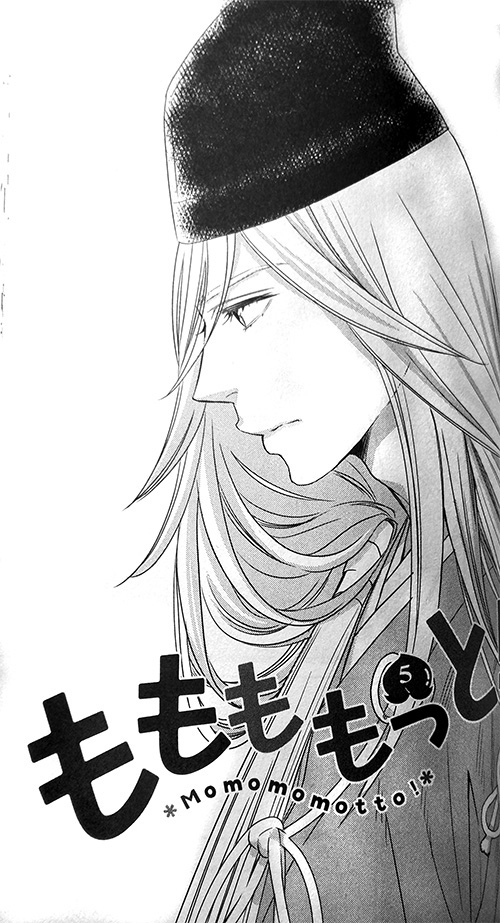 With the only slightly less trying schedule of being published in a monthly magazine, NakajÅ returned to the manga world with a new series titled Momomomotto! (alternatively Momo mo motto!) last year and its first manga volume in January 2017. A closer look at its cover artwork in fresh, spring themed colors reveals a lot of traditional Japanese imagery, including peach and sakura blossoms and a handsome man wearing elegant tradidional garments and an eboshi on his head. Next to him we see an enthusiastically smiling girl and when you turn the book to its backcover, there’s a cute hedgehog giving readers a pretty good idea of what’s to come in Momomomotto! With the combination of an ikemen, a school girl and an animal, things are bound to go down the stereotypical fantasy shÅjo manga route but – spoiler alert! – NakajÅ-sensei turns these clichés into something really enjoyable!
With the only slightly less trying schedule of being published in a monthly magazine, NakajÅ returned to the manga world with a new series titled Momomomotto! (alternatively Momo mo motto!) last year and its first manga volume in January 2017. A closer look at its cover artwork in fresh, spring themed colors reveals a lot of traditional Japanese imagery, including peach and sakura blossoms and a handsome man wearing elegant tradidional garments and an eboshi on his head. Next to him we see an enthusiastically smiling girl and when you turn the book to its backcover, there’s a cute hedgehog giving readers a pretty good idea of what’s to come in Momomomotto! With the combination of an ikemen, a school girl and an animal, things are bound to go down the stereotypical fantasy shÅjo manga route but – spoiler alert! – NakajÅ-sensei turns these clichés into something really enjoyable!
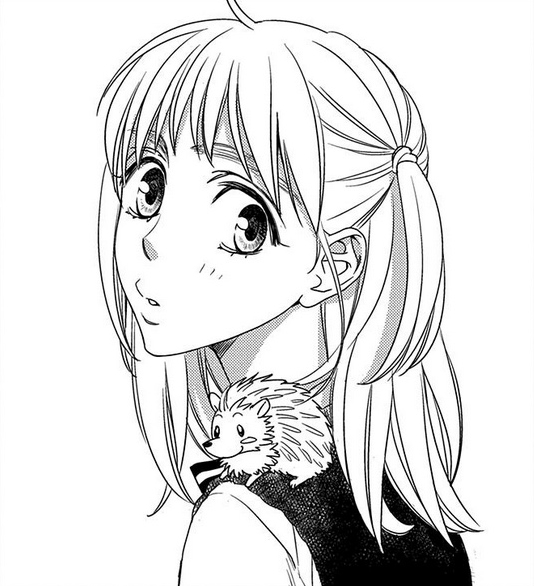
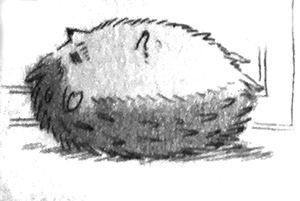 The smiling girl on the cover is, of course, the manga’s heroine. Momose Momo – can a name get any peachier? – is late for her first day of high school. Of course. She’s living with her grandparents after her parents died in an accident. We’ve heard that before. She’s determined to lead a normal school life as your regular school girl. Again, no surprises here. And now regular readers of shÅjo manga know to expect some kind of twist: In this case, Momo has been able to see mononoke, spirits in the form of animals and human-like entities, everywhere ever since an incident in her early childhood. She’s relieved to find that there are only so few of them hanging out on her new school grounds. There’s something else she finds, however: a living being, an animal in distress – a small hedgehog who looks like it might need some good care and food, so Momo takes it back home after school.
The smiling girl on the cover is, of course, the manga’s heroine. Momose Momo – can a name get any peachier? – is late for her first day of high school. Of course. She’s living with her grandparents after her parents died in an accident. We’ve heard that before. She’s determined to lead a normal school life as your regular school girl. Again, no surprises here. And now regular readers of shÅjo manga know to expect some kind of twist: In this case, Momo has been able to see mononoke, spirits in the form of animals and human-like entities, everywhere ever since an incident in her early childhood. She’s relieved to find that there are only so few of them hanging out on her new school grounds. There’s something else she finds, however: a living being, an animal in distress – a small hedgehog who looks like it might need some good care and food, so Momo takes it back home after school.
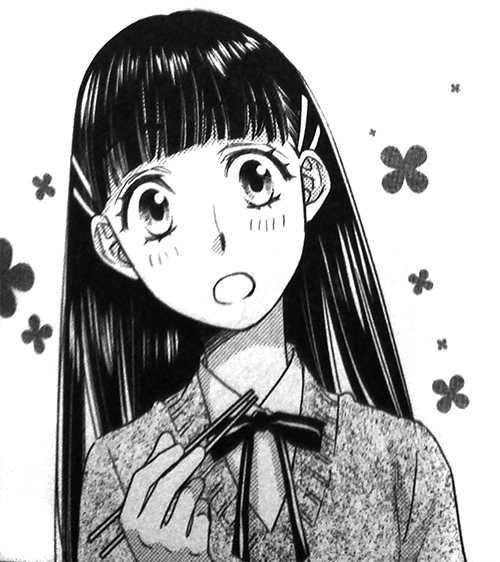
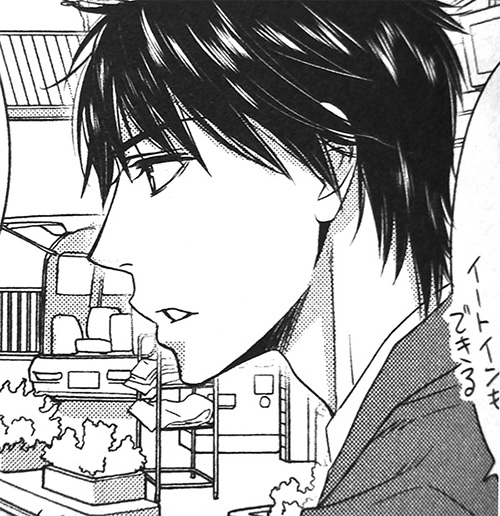 Momo is quickly able to make friends at school. Nishina Sumire, a pretty but down to earth girl, becomes her best friend. The whole school seems to admire her older brother, the star of the archery team. Then there’s Aihara ShirÅ, A boy from her class, who often spends his lunch breaks talking to Momo, and elps her in several situations, knows about her hedgehog after she secretly (and in one case, unknowingly) takes it to school with her. But Momo hasn’t been able to tell Aihara-kun something quite mysterious about the hedghehog yet. The small animal can turn into a human being, a handsome young man dressed in the elegant clothes and hat of a Heian-period nobleman called Harimaru. Only Momo can see his human form, which is quite practical considering he often pops up suddenly at school.
Momo is quickly able to make friends at school. Nishina Sumire, a pretty but down to earth girl, becomes her best friend. The whole school seems to admire her older brother, the star of the archery team. Then there’s Aihara ShirÅ, A boy from her class, who often spends his lunch breaks talking to Momo, and elps her in several situations, knows about her hedgehog after she secretly (and in one case, unknowingly) takes it to school with her. But Momo hasn’t been able to tell Aihara-kun something quite mysterious about the hedghehog yet. The small animal can turn into a human being, a handsome young man dressed in the elegant clothes and hat of a Heian-period nobleman called Harimaru. Only Momo can see his human form, which is quite practical considering he often pops up suddenly at school.
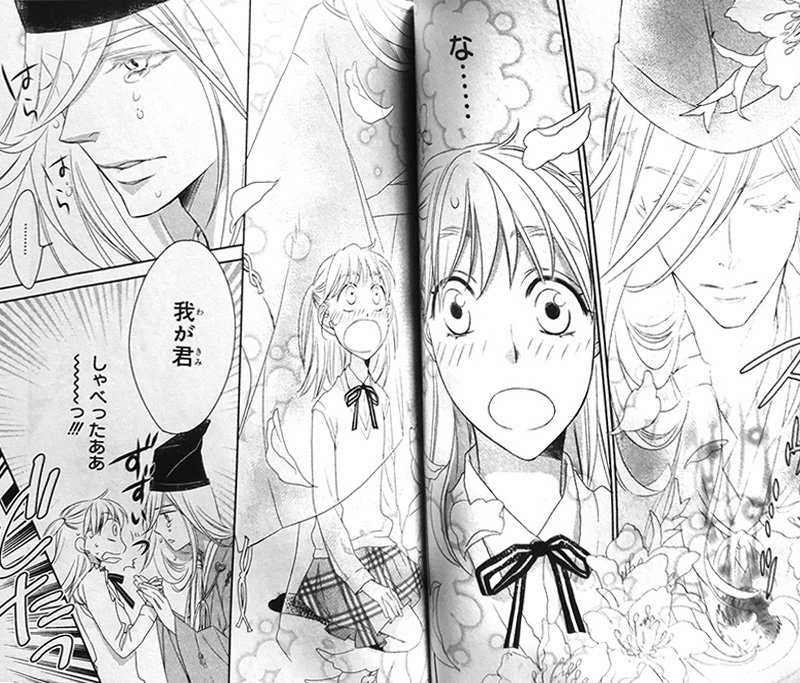
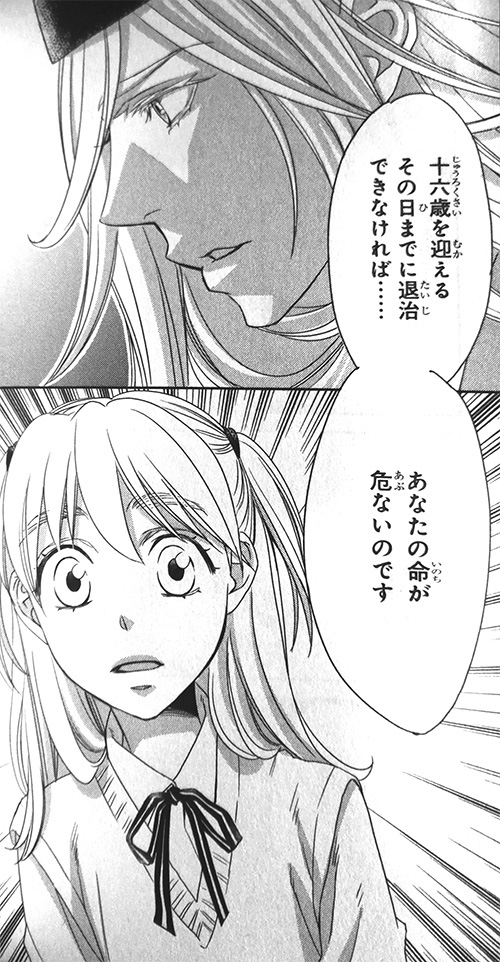 Harimaru has a shocking revelation for Momo. She is the reincarnation of his master MomotarÅ (the hero of a Japanese folktale) while Harimaru used to be his sword. MomotarÅ, along with three friends, fought off demons (oni) who attacked his village but the demons swore revenge and now want to hunt down his current incarnation, none other than Momo. Momo must gather the reincarnations of those three friends around her and fight against those demons, as her life is in danger if she doesn’t slay them until she turns 16. In her past life, after MomotarÅ had slain the last demon, Harimaru broke and all that remained was the blade inside the hilt of the sword. Every time Momo has successfully fought a demon, pieces of the blade appear in the shape of a needle (hari) which then can reunite with Harimaru’s body, helping him regain his strength.
Harimaru has a shocking revelation for Momo. She is the reincarnation of his master MomotarÅ (the hero of a Japanese folktale) while Harimaru used to be his sword. MomotarÅ, along with three friends, fought off demons (oni) who attacked his village but the demons swore revenge and now want to hunt down his current incarnation, none other than Momo. Momo must gather the reincarnations of those three friends around her and fight against those demons, as her life is in danger if she doesn’t slay them until she turns 16. In her past life, after MomotarÅ had slain the last demon, Harimaru broke and all that remained was the blade inside the hilt of the sword. Every time Momo has successfully fought a demon, pieces of the blade appear in the shape of a needle (hari) which then can reunite with Harimaru’s body, helping him regain his strength.
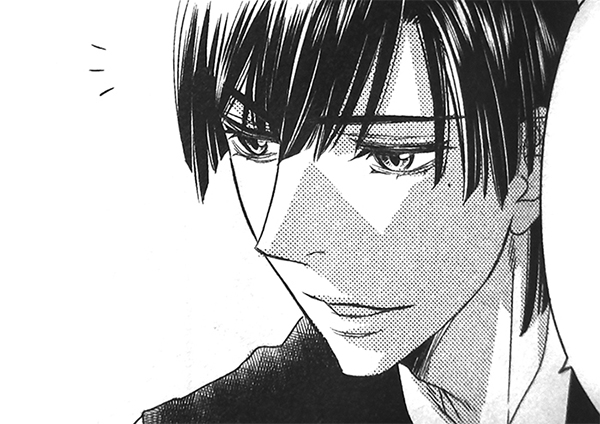
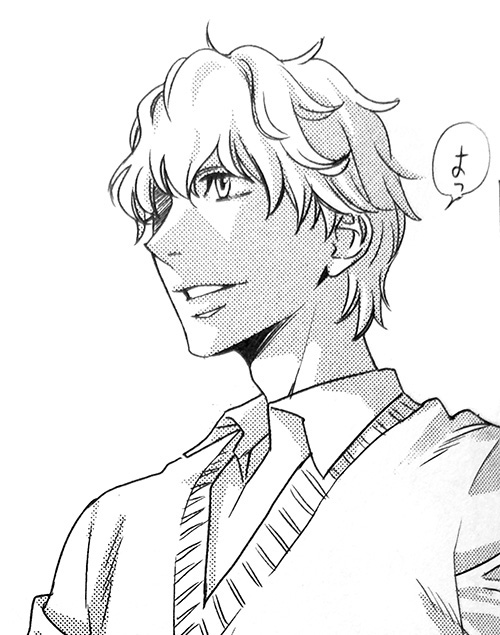 With the support of Aihara Momo is able to fight a demon at school and another one possessing one of their teachers which means two needles for Harimaru. He tells her about the ancient objects her mother did research on before she died, a netsuke shaped like a small hedgehog (a kind of toggle traditionally used by men to fasten small containers or pouches to their belts) and a tsuba, a round carved sword guard which Harimaru instructs Momo to keep close to her body because it will tell her when her three comrades from her previous life as MomotarŠare around. Could it be the tsuba’s doing that Momo suddenly hears a shrill sound at school when she’s surrounded by Aihara, Sumire’s older brother and a mysterious cat-loving boy Momo found sleeping in the school gym?
With the support of Aihara Momo is able to fight a demon at school and another one possessing one of their teachers which means two needles for Harimaru. He tells her about the ancient objects her mother did research on before she died, a netsuke shaped like a small hedgehog (a kind of toggle traditionally used by men to fasten small containers or pouches to their belts) and a tsuba, a round carved sword guard which Harimaru instructs Momo to keep close to her body because it will tell her when her three comrades from her previous life as MomotarŠare around. Could it be the tsuba’s doing that Momo suddenly hears a shrill sound at school when she’s surrounded by Aihara, Sumire’s older brother and a mysterious cat-loving boy Momo found sleeping in the school gym?
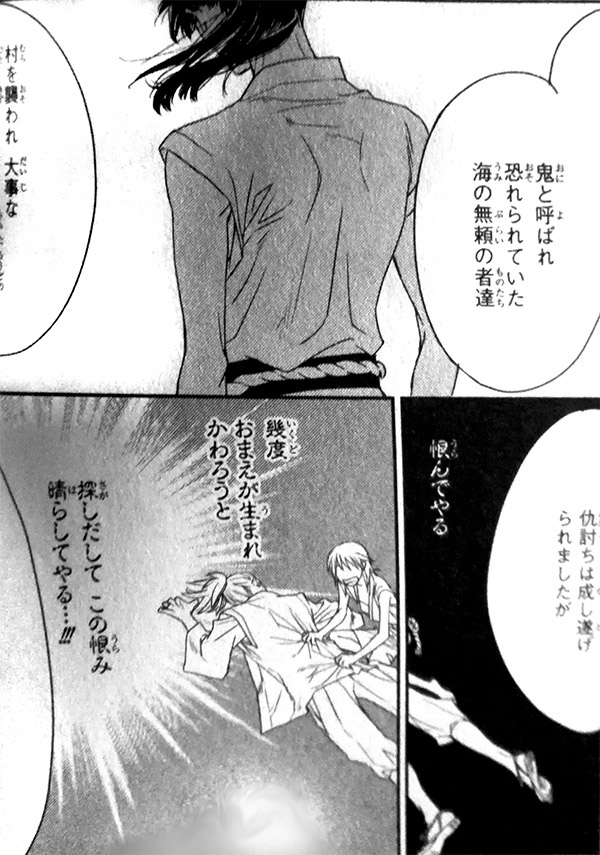 Thus ends the first volume of this promising return of NakajÅ Hisaya. Once you get to the last page, you’ve encountered a ton of shÅjo manga tropes. If you’re even remotely familiar with them, the plot turns here won’t be all that surprising. But there are also some very short flashbacks to events in Momo’s past and her previous life as MomotarÅ, like images of a young boy crying at the seashore for example, which keep the story mysterious and engaging. However, they do not really complicate the story which is pretty straight forward and easy to follow, favoring action, comedy and pretty boys over introspection and the depiction of psychological depth. But in the end, this serves the series’ fun and light atmosphere, turning it into a quick and entertaining read.
Thus ends the first volume of this promising return of NakajÅ Hisaya. Once you get to the last page, you’ve encountered a ton of shÅjo manga tropes. If you’re even remotely familiar with them, the plot turns here won’t be all that surprising. But there are also some very short flashbacks to events in Momo’s past and her previous life as MomotarÅ, like images of a young boy crying at the seashore for example, which keep the story mysterious and engaging. However, they do not really complicate the story which is pretty straight forward and easy to follow, favoring action, comedy and pretty boys over introspection and the depiction of psychological depth. But in the end, this serves the series’ fun and light atmosphere, turning it into a quick and entertaining read.
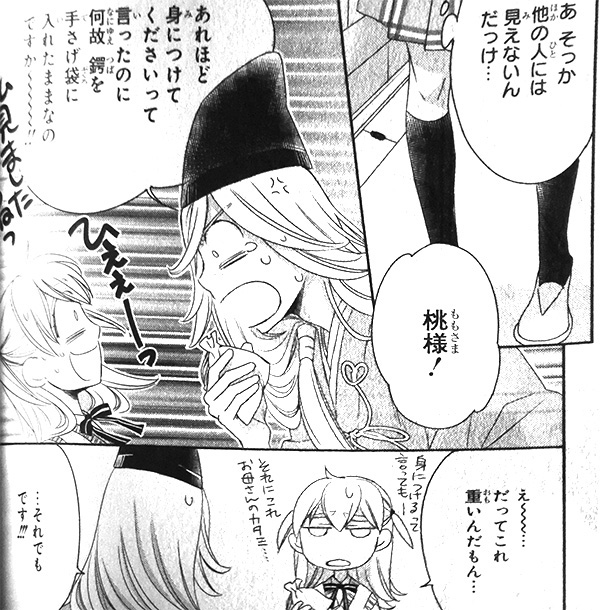
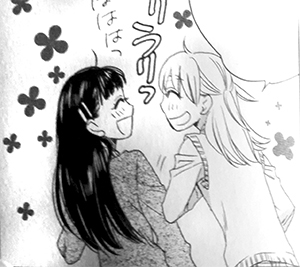 The dynamic and often prettily decorated page layouts offer a mix of scenes of school and domestic life, shots of pretty boys and quick-fire dialogues providing comic relief from the suspense of Momo’s quest to find her group of former friends and stop the demons’ plan of revenge. And most importantly, there’s a lot of eye candy here in the form of pretty boys and the handsome man that is Harimaru, often presented in NakajÅ’s trademark profiles. To balance that out, we have the slightly klutzy but passionate and relatable protagonist Momo and Harimaru’s cute animal form. Also notable is the depiction of the friendship between the two girls Momo and Sumire which I hope to see more of in future chapters!
The dynamic and often prettily decorated page layouts offer a mix of scenes of school and domestic life, shots of pretty boys and quick-fire dialogues providing comic relief from the suspense of Momo’s quest to find her group of former friends and stop the demons’ plan of revenge. And most importantly, there’s a lot of eye candy here in the form of pretty boys and the handsome man that is Harimaru, often presented in NakajÅ’s trademark profiles. To balance that out, we have the slightly klutzy but passionate and relatable protagonist Momo and Harimaru’s cute animal form. Also notable is the depiction of the friendship between the two girls Momo and Sumire which I hope to see more of in future chapters!
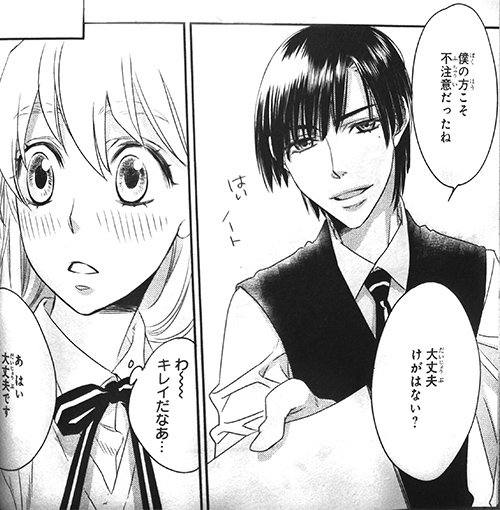 The image arsenal of traditional Japanese items but also the names and the allusion to the folktale of MomotarÅ, his three animal friends and their quest to defend an island from a group of demons are the manga’s visual and narrative backbone. It’s the mixture of these very elements and the present-day school life that lend the manga a true flavour of its own. It’s admittedly not reinventing the wheel called shÅjo manga. But it features such a great cast of likeable and mysterious characters, a lot of readers will find themselves become attached to them very quickly to follow Momo’s and Harimaru’s quest. This mix of fantasy, school life, action and comedy also leaves room for quieter moments and the development of friendships. It is always entertaining and very reminiscent of the old school Hana to Yume magic, leaving readers wanting more! The only thing that’s holding up the fast pace the first volume has set is its slow release rhythm caused by the fact it’s being published in a monthly magazine. The next volume won’t be out until September at the earliest. I believe this series will settle at a one new tankÅbon every 8-9 months rhythm with the coming volumes which means plenty of time between releases if you’re a not a magazine buyer :( But so far, this title is definitely worth the wait! I’m very curious to see where Momo’s journey is headed and if the series can manage to keep its high-octane pace!
The image arsenal of traditional Japanese items but also the names and the allusion to the folktale of MomotarÅ, his three animal friends and their quest to defend an island from a group of demons are the manga’s visual and narrative backbone. It’s the mixture of these very elements and the present-day school life that lend the manga a true flavour of its own. It’s admittedly not reinventing the wheel called shÅjo manga. But it features such a great cast of likeable and mysterious characters, a lot of readers will find themselves become attached to them very quickly to follow Momo’s and Harimaru’s quest. This mix of fantasy, school life, action and comedy also leaves room for quieter moments and the development of friendships. It is always entertaining and very reminiscent of the old school Hana to Yume magic, leaving readers wanting more! The only thing that’s holding up the fast pace the first volume has set is its slow release rhythm caused by the fact it’s being published in a monthly magazine. The next volume won’t be out until September at the earliest. I believe this series will settle at a one new tankÅbon every 8-9 months rhythm with the coming volumes which means plenty of time between releases if you’re a not a magazine buyer :( But so far, this title is definitely worth the wait! I’m very curious to see where Momo’s journey is headed and if the series can manage to keep its high-octane pace!
Title: Momo mo motto! (ã‚‚ã‚‚ã‚‚ã‚‚ã£ã¨!; stylized as Momomomotto!)
Author: NakajÅ Hisaya (ä¸æ¡æ¯”紗也)
Volumes: 1 (ongoing; 2017-)
Magazine: Bessatsu Hana to Yume
Label: Hana to Yume Comics
Publisher: Hakusensha
Additional information: Sample the first chapter of the first volume on Hakusensha’s info page via the tameshiyomi link.

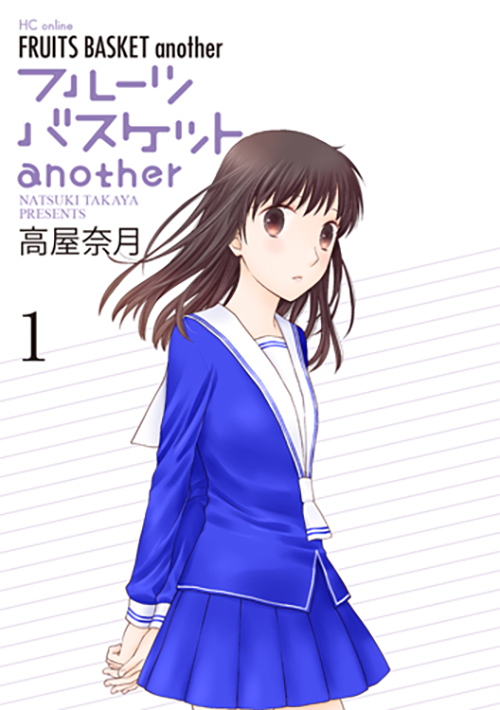 If you were a manga reader around the time the world moved into the current millenium, you probably remember the birth of an unforgettable shÅjo manga mega hit series featuring a lonely girl meeting a mysterious clan of people cursed to turn into animals under various circumstances. While Takaya Natsuki‘s manga Fruits Basket, published in Hakusensha’s bimonthly magazine Hana to Yume, had already started its run in 1998, it was in 2001, with the winning of the Kodansha Manga Award in the shÅjo manga category and – most importantly – the airing of its TV anime adaptation, that Fruits Basket crossed age and gender barriers and captured the hearts of so many people, girls and women, boys and men alike. And it turned the series not just into a stellar success story in Japan but internationally as well where it also gained a huge fan following. The manga series itself ran until 2006, its 23 tankÅbon volumes selling millions of copies in its home country and, as translated versions, abroad.
If you were a manga reader around the time the world moved into the current millenium, you probably remember the birth of an unforgettable shÅjo manga mega hit series featuring a lonely girl meeting a mysterious clan of people cursed to turn into animals under various circumstances. While Takaya Natsuki‘s manga Fruits Basket, published in Hakusensha’s bimonthly magazine Hana to Yume, had already started its run in 1998, it was in 2001, with the winning of the Kodansha Manga Award in the shÅjo manga category and – most importantly – the airing of its TV anime adaptation, that Fruits Basket crossed age and gender barriers and captured the hearts of so many people, girls and women, boys and men alike. And it turned the series not just into a stellar success story in Japan but internationally as well where it also gained a huge fan following. The manga series itself ran until 2006, its 23 tankÅbon volumes selling millions of copies in its home country and, as translated versions, abroad.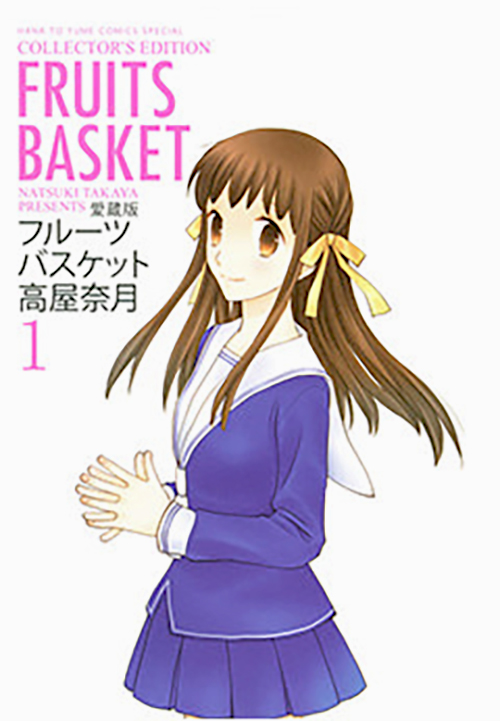 In 2015 the publication of a 12-volume Fruits Basket Collector’s Edition (aizÅban), designed in a slightly larger format than the original tankÅbon version and with additional color illustrations and features like interviews and character profiles, was announced. To create some buzz and promote the sale of this edition (released monthly until August 2016), Takaya Natsuki returned to the world of Fruits Basket and began to publish chapters of a new Fruits Basket series via Hakusensha’s digital platform Hana Lala online. A year later, these chapters saw a serialization in paper form in the monthly magazine Bessatsu Hana to Yume before the first volume was finally published in tankÅbon format in August 2016. This new series is titled Fruits Basket another (or Furubana, similar to the abbreviated Furuba of its predecessor), which hints at an alternative universe kind of relationship with the original series about the the girl Honda TÅru and the members of the SÅma (Sohma) clan who are cursed to transform into one animal of the Chinese zodiac plus a cat respectively when they’re either in bad physical or mental states or touched by members of the opposite sex. However, the events in Furubana take place in the very same SÅma clan universe as Furuba!
In 2015 the publication of a 12-volume Fruits Basket Collector’s Edition (aizÅban), designed in a slightly larger format than the original tankÅbon version and with additional color illustrations and features like interviews and character profiles, was announced. To create some buzz and promote the sale of this edition (released monthly until August 2016), Takaya Natsuki returned to the world of Fruits Basket and began to publish chapters of a new Fruits Basket series via Hakusensha’s digital platform Hana Lala online. A year later, these chapters saw a serialization in paper form in the monthly magazine Bessatsu Hana to Yume before the first volume was finally published in tankÅbon format in August 2016. This new series is titled Fruits Basket another (or Furubana, similar to the abbreviated Furuba of its predecessor), which hints at an alternative universe kind of relationship with the original series about the the girl Honda TÅru and the members of the SÅma (Sohma) clan who are cursed to transform into one animal of the Chinese zodiac plus a cat respectively when they’re either in bad physical or mental states or touched by members of the opposite sex. However, the events in Furubana take place in the very same SÅma clan universe as Furuba!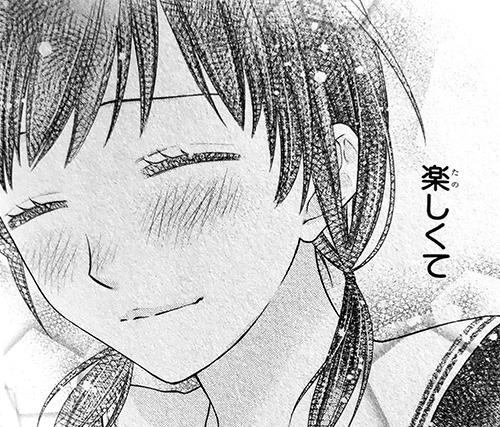 Chronologically, Fruits Basket another is set several years after the original series. A girl called Mitoma Sawa is supposed to start her first day at Kaibara-kÅkÅ, the same senior high school the main Furuba characters used to go to back in their days. Sawa is an only child living with her cold, mostly absent mother. She doesn’t want to cause trouble for anybody after a bad experience in elementary school which left her alone without friends. In best shÅjo manga fashion she wants to start fresh in high school. She might be on her way to a catastrophic beginning when she is late for her first day and gets scolded by a teacher but she is then saved by a good-looking boy called SÅma Mutsuki (why hello there, Furuba Yuki!). Together with another student and member of the SÅma clan, Hajime (a look-a-like of none other than KyÅ, of course), Mutsuki wants Sawa to become a member of the student council and makes it publically known she was selected as a new member. Timid Sawa doesn’t really have a choice anymore, accepts her new position and joins president Hajime and vice president Mutsuki.
Chronologically, Fruits Basket another is set several years after the original series. A girl called Mitoma Sawa is supposed to start her first day at Kaibara-kÅkÅ, the same senior high school the main Furuba characters used to go to back in their days. Sawa is an only child living with her cold, mostly absent mother. She doesn’t want to cause trouble for anybody after a bad experience in elementary school which left her alone without friends. In best shÅjo manga fashion she wants to start fresh in high school. She might be on her way to a catastrophic beginning when she is late for her first day and gets scolded by a teacher but she is then saved by a good-looking boy called SÅma Mutsuki (why hello there, Furuba Yuki!). Together with another student and member of the SÅma clan, Hajime (a look-a-like of none other than KyÅ, of course), Mutsuki wants Sawa to become a member of the student council and makes it publically known she was selected as a new member. Timid Sawa doesn’t really have a choice anymore, accepts her new position and joins president Hajime and vice president Mutsuki.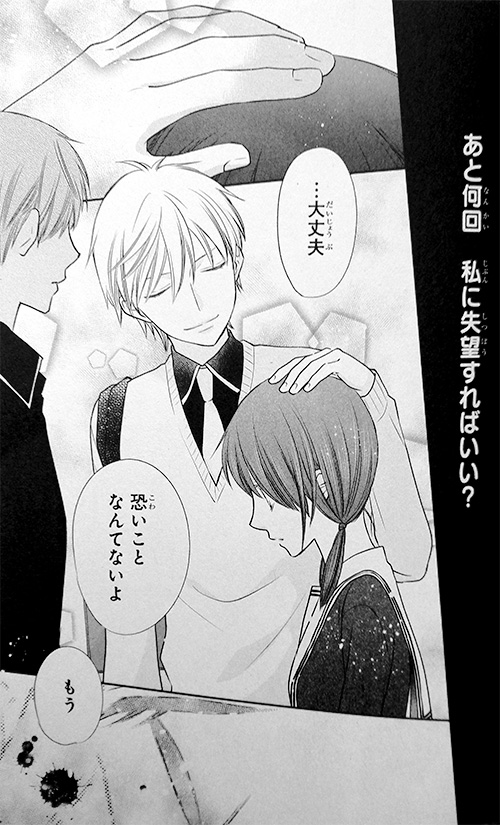
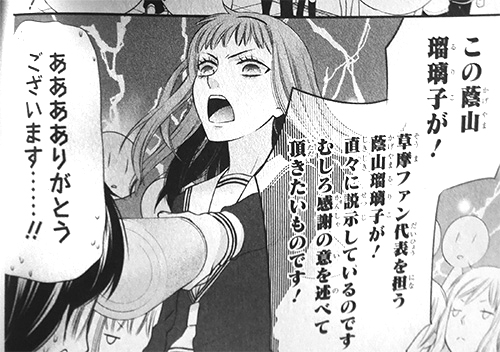 Mutsuki saves Sawa from awkward social situations more than once. He appears outwardly gentle but is a bit of a bully towards Hajime who has a very short temper. (That should ring a bell concerning the relationship of the Furuba generation protagonists, Yuki and KyÅ.) The SÅma family members are hugely popular at their school and even have their own fan club led by the overzealous Kakeyama Ruriko, who hysterically guards Mutsuki’s well-being and is highly suspicious of Sawa’s closeness to the SÅma clan which complicates Sawa’s life at school only further. By meeting more members of the SÅma clan who either also go to Kaibara-kÅkÅ or come to visit Hajime and Mutsuki in their house, Sawa gets to know the clan members’ very unique personalities. Little by little she starts to relax and make friends among the SÅmas, but will she be able to overcome her past trauma and find a place – or in this case, a family clan – she belongs to? And how will her presence in return affect the SÅma clan and their complicated relationships with each other?
Mutsuki saves Sawa from awkward social situations more than once. He appears outwardly gentle but is a bit of a bully towards Hajime who has a very short temper. (That should ring a bell concerning the relationship of the Furuba generation protagonists, Yuki and KyÅ.) The SÅma family members are hugely popular at their school and even have their own fan club led by the overzealous Kakeyama Ruriko, who hysterically guards Mutsuki’s well-being and is highly suspicious of Sawa’s closeness to the SÅma clan which complicates Sawa’s life at school only further. By meeting more members of the SÅma clan who either also go to Kaibara-kÅkÅ or come to visit Hajime and Mutsuki in their house, Sawa gets to know the clan members’ very unique personalities. Little by little she starts to relax and make friends among the SÅmas, but will she be able to overcome her past trauma and find a place – or in this case, a family clan – she belongs to? And how will her presence in return affect the SÅma clan and their complicated relationships with each other?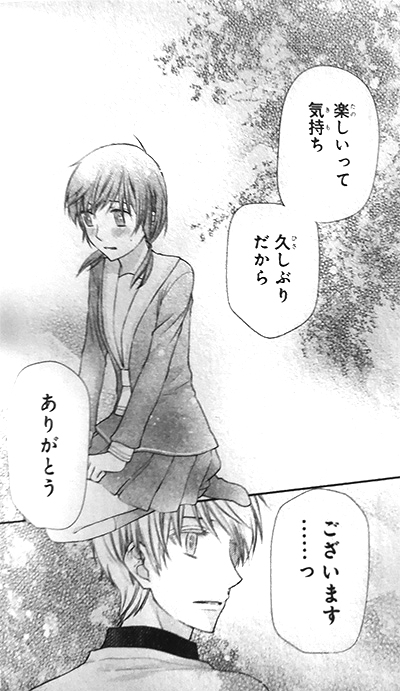 From this short summary alone it should be obvious that just like its predecessor, Fruits Basket another belongs to the healing (iyashi-kei) manga genre. The premise of the original – how is TÅru changed by the SÅma clan and how does she in return change the SÅma clan dynamics – is kept and applied to the protagonist Sawa. Unfortunately for the reader, Sawa so far seems like a rather plain and uninteresting heroine by comparison and is mainly used as a tool to build a stage for the new generation of SÅma clan members who make their appearances one by one. Furubana is planned as a 3-volume series so there clearly isn’t enough space to draw out the story as elaborately as Furuba did which means some SÅma family members here disappear just as quickly as they’ve entered the stage. In the first volume we do get some dark foreshadowing when Mutsuki repeatedly calls a mysterious person called Shiki who avoids meeting Sawa face to face, a hint that the series might hide some darker secrets below its surface, just like the original series did.
From this short summary alone it should be obvious that just like its predecessor, Fruits Basket another belongs to the healing (iyashi-kei) manga genre. The premise of the original – how is TÅru changed by the SÅma clan and how does she in return change the SÅma clan dynamics – is kept and applied to the protagonist Sawa. Unfortunately for the reader, Sawa so far seems like a rather plain and uninteresting heroine by comparison and is mainly used as a tool to build a stage for the new generation of SÅma clan members who make their appearances one by one. Furubana is planned as a 3-volume series so there clearly isn’t enough space to draw out the story as elaborately as Furuba did which means some SÅma family members here disappear just as quickly as they’ve entered the stage. In the first volume we do get some dark foreshadowing when Mutsuki repeatedly calls a mysterious person called Shiki who avoids meeting Sawa face to face, a hint that the series might hide some darker secrets below its surface, just like the original series did.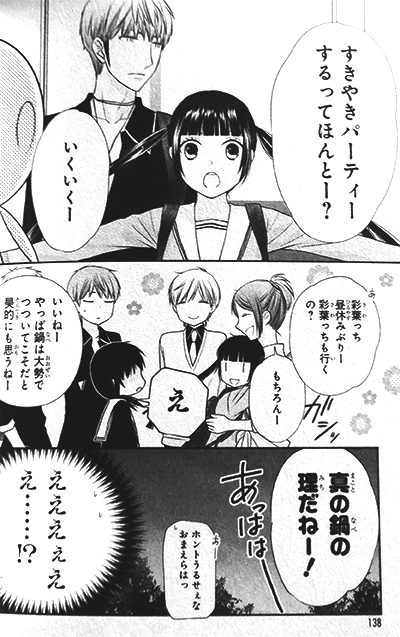 Throughout the manga long-time followers of the series will be able to play guessing games trying to match Furubana children with their supposed Furuba parents by their looks, behavior and character traits. The Furubana offspring are missing the key characteristic of the Fruits Basket generation though (as a result of the ending of the original series, which I’m not going to spoil here), which is exactly what made Fruits Basket so special, plot-wise and visually: the transformation into animals and the problems this caused. It might seem like an extremely lazy analogy but try to imagine a Sailor Moon another as a high school comedy of the children of the Sailor Senshi without their magical planet powers and transformations and ask yourself if you’re enough of a die-hard fan to find entertainment in that…
Throughout the manga long-time followers of the series will be able to play guessing games trying to match Furubana children with their supposed Furuba parents by their looks, behavior and character traits. The Furubana offspring are missing the key characteristic of the Fruits Basket generation though (as a result of the ending of the original series, which I’m not going to spoil here), which is exactly what made Fruits Basket so special, plot-wise and visually: the transformation into animals and the problems this caused. It might seem like an extremely lazy analogy but try to imagine a Sailor Moon another as a high school comedy of the children of the Sailor Senshi without their magical planet powers and transformations and ask yourself if you’re enough of a die-hard fan to find entertainment in that…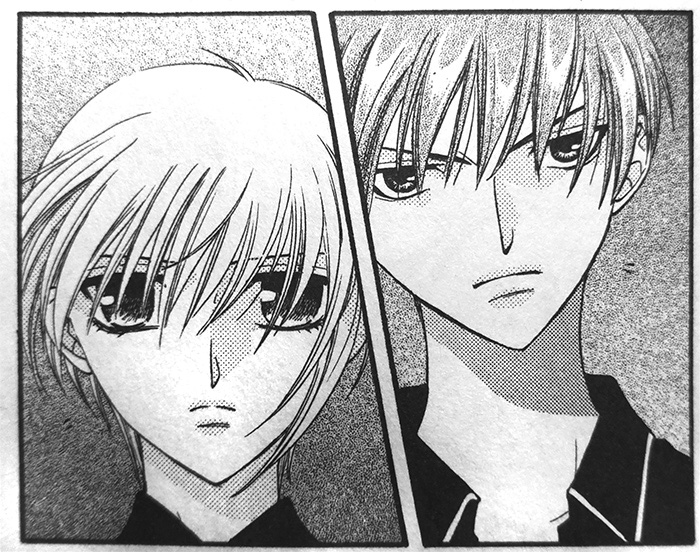
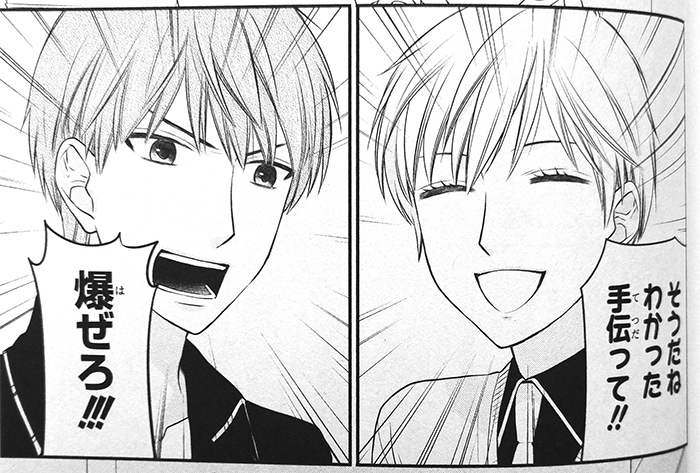
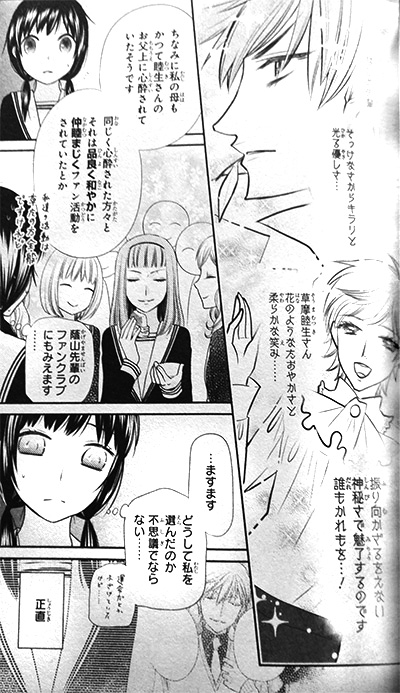 Fruits Basket was always character-driven with lots of back story and psychological development provided through the dialogue. The story here is paper-thin however, with depth and darkness as of yet only hinted at. While the character designs are solid and very similar to those of the later volumes of the original series, the main setting of the school itself makes for some boring and repetitive page layouts. So far there have been only very few scenes set outside, at the SÅma house for example. After reading the first volume one cannot shake the feeling that everything here is just a taste of past glory. Even the main character constellation – Sawa, Mutsuki, Hajime – is all too similar to the TÅru-Yuki-KyÅ triangle. Owing to the planned shortness of the series, the chances of it going as dark as the original or putting its readers on an engaging emotional rollercoaster in the future are admittedly low. This is a real weakness of this sequel, as fans of the original who followed it in ‘real time’ back in the early 2000s are all adults now, doubtlessly possessing the mental capabilities to process a slightly more complex story.
Fruits Basket was always character-driven with lots of back story and psychological development provided through the dialogue. The story here is paper-thin however, with depth and darkness as of yet only hinted at. While the character designs are solid and very similar to those of the later volumes of the original series, the main setting of the school itself makes for some boring and repetitive page layouts. So far there have been only very few scenes set outside, at the SÅma house for example. After reading the first volume one cannot shake the feeling that everything here is just a taste of past glory. Even the main character constellation – Sawa, Mutsuki, Hajime – is all too similar to the TÅru-Yuki-KyÅ triangle. Owing to the planned shortness of the series, the chances of it going as dark as the original or putting its readers on an engaging emotional rollercoaster in the future are admittedly low. This is a real weakness of this sequel, as fans of the original who followed it in ‘real time’ back in the early 2000s are all adults now, doubtlessly possessing the mental capabilities to process a slightly more complex story.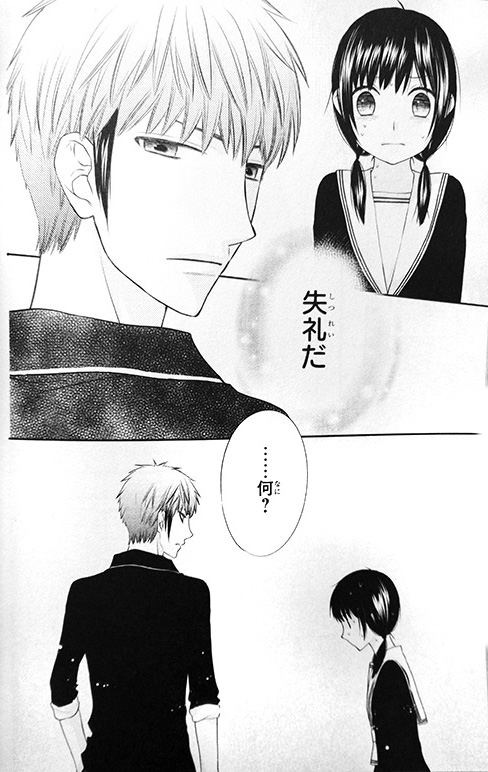 The characters, in their visual appearances and behaviors but also in their dialogues, provide recurring hints and references to the original Fruits Basket series which are only comprehensible to those who know and remember (!) the original series. In this way, Fruits Basket another can be seen as a present to long-time fans and was clearly not made to win people new to the series over. The author constantly plugs the aizÅban/collector’s edition that was released with the start of Furubana, encouraging people to (re)buy and (re)read the original. However, I have my doubts if people with no prior knowledge of Fruits Basket who start with Furubana find the latter fascinating enough to start the original series, especially because it lacks everything that made Fruits Basket so entertaining and fascinating.
The characters, in their visual appearances and behaviors but also in their dialogues, provide recurring hints and references to the original Fruits Basket series which are only comprehensible to those who know and remember (!) the original series. In this way, Fruits Basket another can be seen as a present to long-time fans and was clearly not made to win people new to the series over. The author constantly plugs the aizÅban/collector’s edition that was released with the start of Furubana, encouraging people to (re)buy and (re)read the original. However, I have my doubts if people with no prior knowledge of Fruits Basket who start with Furubana find the latter fascinating enough to start the original series, especially because it lacks everything that made Fruits Basket so entertaining and fascinating.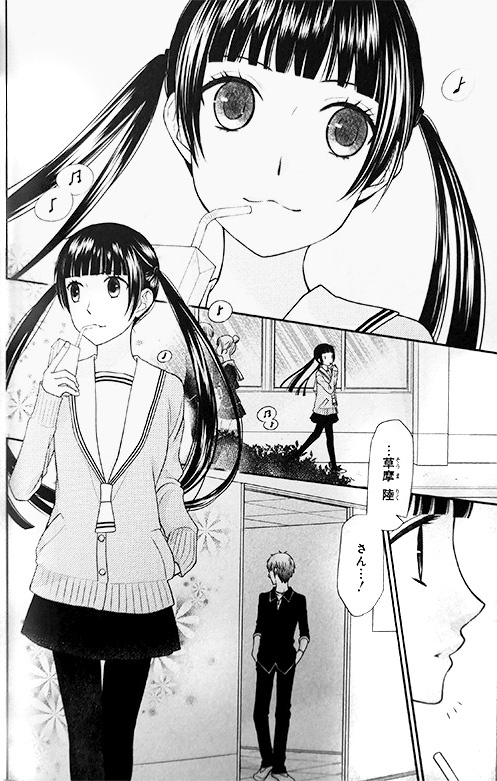 The unique characters of the second generation of the SÅma clan and their gorgeous character designs, the bickering between its two main family members (Mutsuki and Hajime here, the supposed sons of Yuki and KyÅ) and the sometimes over-the-top humor here are reminders of key elements of the original. Hints at darker motives of characters are given throughout the first volume and especially at the end, providing a cliffhanger to buy the next volume which should be out by late summer/early fall 2017. In its current form, I have to admit this spin-off doesn’t leave much of a lingering impression. Maybe it will be more satisfying once the series has ended and it can be enjoyed in full. It did however make me want to revisit the original which I find has aged perfectly, with its soft and kind gentleness winning over cruelty and isolation.
The unique characters of the second generation of the SÅma clan and their gorgeous character designs, the bickering between its two main family members (Mutsuki and Hajime here, the supposed sons of Yuki and KyÅ) and the sometimes over-the-top humor here are reminders of key elements of the original. Hints at darker motives of characters are given throughout the first volume and especially at the end, providing a cliffhanger to buy the next volume which should be out by late summer/early fall 2017. In its current form, I have to admit this spin-off doesn’t leave much of a lingering impression. Maybe it will be more satisfying once the series has ended and it can be enjoyed in full. It did however make me want to revisit the original which I find has aged perfectly, with its soft and kind gentleness winning over cruelty and isolation.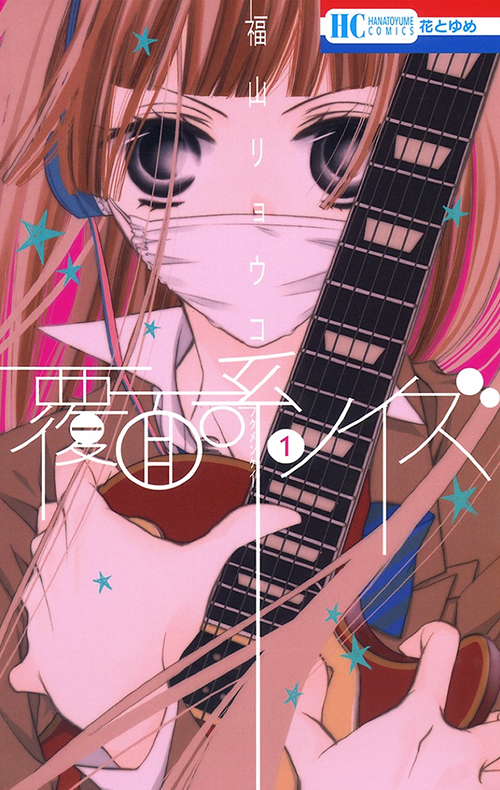 As a young girl, Arisugawa Nino used to sing with Yuzu, the boy living in the house next to her family’s, which gave her strength and comfort when her parents were fighting. Yuzu moves away one day but Nino is lucky enough to become friends with Yuzu, a boy who composes songs for Nino until he too moves away. Nino is determined to find both Nino and Yuzu again through her singing voice which might lead them back to her. Now, in senior high, Nino is surprised to meet Yuzu who is secretly in the popular newcomer band in NO hurry to shout (Inohari) whose members are wearing bandages and eye-patches to hide their identities. Yuzu asks Nino to join them as their lead singer Alice and this inspires him to write new songs for the band. Nino doesn’t yet know that none other than Momo is now a) a famous pop composer, b) the bassist of a band called SILENT BLACK KITTY (Kuroneko) criticized for being an Inohari copy band plus c) a student in the school Nino and Yuzu attend. When they finally meet again, Momo rejects Nino as he secretly feels ashamed he sold his songs originally written for Nino to other pop singers while Yuzu also has his eyes set on Nino, his Alice – another one-sided love in this triangle that fuels the creative energy of these three young people.
As a young girl, Arisugawa Nino used to sing with Yuzu, the boy living in the house next to her family’s, which gave her strength and comfort when her parents were fighting. Yuzu moves away one day but Nino is lucky enough to become friends with Yuzu, a boy who composes songs for Nino until he too moves away. Nino is determined to find both Nino and Yuzu again through her singing voice which might lead them back to her. Now, in senior high, Nino is surprised to meet Yuzu who is secretly in the popular newcomer band in NO hurry to shout (Inohari) whose members are wearing bandages and eye-patches to hide their identities. Yuzu asks Nino to join them as their lead singer Alice and this inspires him to write new songs for the band. Nino doesn’t yet know that none other than Momo is now a) a famous pop composer, b) the bassist of a band called SILENT BLACK KITTY (Kuroneko) criticized for being an Inohari copy band plus c) a student in the school Nino and Yuzu attend. When they finally meet again, Momo rejects Nino as he secretly feels ashamed he sold his songs originally written for Nino to other pop singers while Yuzu also has his eyes set on Nino, his Alice – another one-sided love in this triangle that fuels the creative energy of these three young people.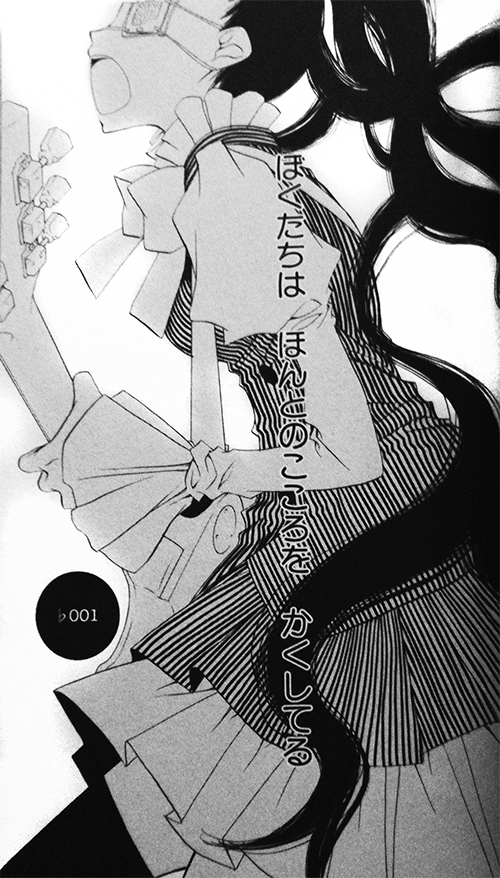 This is the premise of Fukuyama RyÅko’s manga Fukumenkei Noise (Anonymous Noise) which has been running in Hakusensha’s Hana to Yume magazine since 2013, with 12 comic volumes published so far. This is already quite a long series with probably much more material to follow but it doesn’t take more than the first and a little bit of the second volume for the foundation of the plot to be established. One copyline repeatedly used for the series is “Kokoro kakushita kataomoi melody” which roughly translates to “The melody of unrequited love hiding our try feelings” and cleverly refers to Fukumenkei Noise‘s two main elements: romance and music. Inohari’s and Kuroneko’s respective roads to success and their rivalry always run parallel to the main love triangle with all those feelings of attraction and the need for distance it entails plus the side stories also filled with stories of unrequited love. We have Nino who is in love with Momo, Momo who won’t allow himself to return Nino’s feelings, Yuzu who has more than just feelings of inspiration for Nino, Miou who has a crush on Yuzu, Haruyoshi who wants Miou to forget about Yuzu, Kuro who is in love with his older brother’s wife… Yes, we’re in for quite a bit of heartache.
This is the premise of Fukuyama RyÅko’s manga Fukumenkei Noise (Anonymous Noise) which has been running in Hakusensha’s Hana to Yume magazine since 2013, with 12 comic volumes published so far. This is already quite a long series with probably much more material to follow but it doesn’t take more than the first and a little bit of the second volume for the foundation of the plot to be established. One copyline repeatedly used for the series is “Kokoro kakushita kataomoi melody” which roughly translates to “The melody of unrequited love hiding our try feelings” and cleverly refers to Fukumenkei Noise‘s two main elements: romance and music. Inohari’s and Kuroneko’s respective roads to success and their rivalry always run parallel to the main love triangle with all those feelings of attraction and the need for distance it entails plus the side stories also filled with stories of unrequited love. We have Nino who is in love with Momo, Momo who won’t allow himself to return Nino’s feelings, Yuzu who has more than just feelings of inspiration for Nino, Miou who has a crush on Yuzu, Haruyoshi who wants Miou to forget about Yuzu, Kuro who is in love with his older brother’s wife… Yes, we’re in for quite a bit of heartache.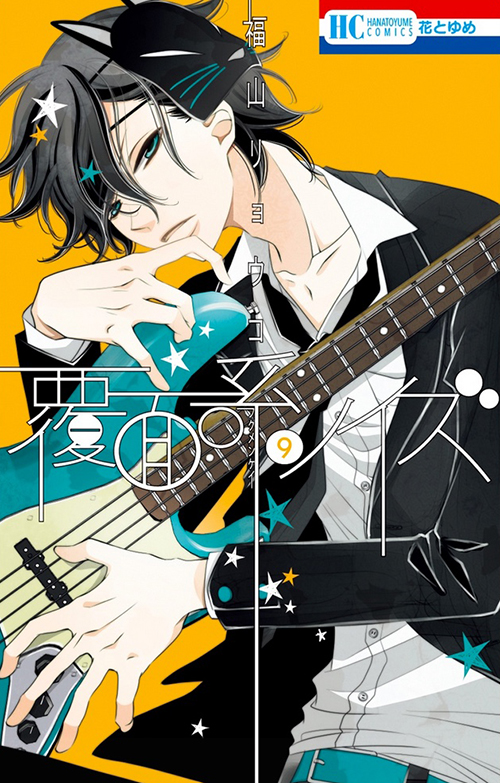 But the backbone of the series is definitely the music aspect. Nino’s journey toward becoming a stronger singer who tries to reach out for her audience and the other main characters’ developments as artists give the series an interesting focus beyond the romance aspect. The dynamics within Inohari make the manga fun and entertaining, as Nino/Alice, Yuzu, Miou, Haruyoshi and Kuro have a lively (but also emotional and complicated) chemistry among themselves. Their rise within the music scene is maybe not completely realistic but it doesn’t leave out the hard work, planning and practice it takes to compose, record and perform hit singles and albums. And it’s that last aspect, the live performances so powerfully put into images in the manga that lend Fukumenkei Noise an almost irresistable sense of pressing urgency and youthful energy. Fukuyama RyÅko relies a lot on her own research and photos she’s taking at concerts and festivals for her visual portrayal of Inohari as a live band. And it definitely pays off because as a reader you do feel the adrenaline rush both of the band and the audience – which is so important because as a manga, the series can’t rely on the key ingredient of the story, the music itself!
But the backbone of the series is definitely the music aspect. Nino’s journey toward becoming a stronger singer who tries to reach out for her audience and the other main characters’ developments as artists give the series an interesting focus beyond the romance aspect. The dynamics within Inohari make the manga fun and entertaining, as Nino/Alice, Yuzu, Miou, Haruyoshi and Kuro have a lively (but also emotional and complicated) chemistry among themselves. Their rise within the music scene is maybe not completely realistic but it doesn’t leave out the hard work, planning and practice it takes to compose, record and perform hit singles and albums. And it’s that last aspect, the live performances so powerfully put into images in the manga that lend Fukumenkei Noise an almost irresistable sense of pressing urgency and youthful energy. Fukuyama RyÅko relies a lot on her own research and photos she’s taking at concerts and festivals for her visual portrayal of Inohari as a live band. And it definitely pays off because as a reader you do feel the adrenaline rush both of the band and the audience – which is so important because as a manga, the series can’t rely on the key ingredient of the story, the music itself!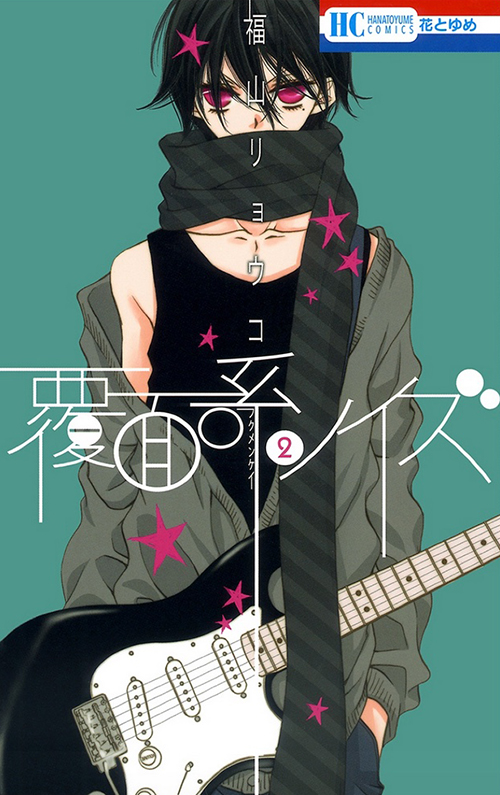 A very minor flaw I’ve noticed is the series is already quite long and there are parts where the plot stalls a little and doesn’t move along as quickly as you’d like. For example, the urgency and speed of the first two volumes are soon replaced by somewhat repetitive scenes of Nino/Alice running amok on stage with her voice, Nino running after Momo has heard her voice while Yuzu’s looking sadly after her, determined to make her voice his. We often get poetic monologues, with sometimes Nino’s and Yuzu’s thoughts running in synchronicity throughout a scene. This can be both a little overwhelming and confusing from time to time, but in the original Japanese version you can at least formally tell their lines apart as Yuzu’s are displayed in hiragana. At the same time, this adds to the sense of chaos and sheer NOISE in the manga which helps build up a very unique atmosphere. And ultimately, the slower chapters serve to build up tension until a change finally happens, for example when Nino overcomes her slump after the band’s first festival appearance and realizes she needs to become a better vocalist by training hard and trying to reach out to the audience in front of her.
A very minor flaw I’ve noticed is the series is already quite long and there are parts where the plot stalls a little and doesn’t move along as quickly as you’d like. For example, the urgency and speed of the first two volumes are soon replaced by somewhat repetitive scenes of Nino/Alice running amok on stage with her voice, Nino running after Momo has heard her voice while Yuzu’s looking sadly after her, determined to make her voice his. We often get poetic monologues, with sometimes Nino’s and Yuzu’s thoughts running in synchronicity throughout a scene. This can be both a little overwhelming and confusing from time to time, but in the original Japanese version you can at least formally tell their lines apart as Yuzu’s are displayed in hiragana. At the same time, this adds to the sense of chaos and sheer NOISE in the manga which helps build up a very unique atmosphere. And ultimately, the slower chapters serve to build up tension until a change finally happens, for example when Nino overcomes her slump after the band’s first festival appearance and realizes she needs to become a better vocalist by training hard and trying to reach out to the audience in front of her.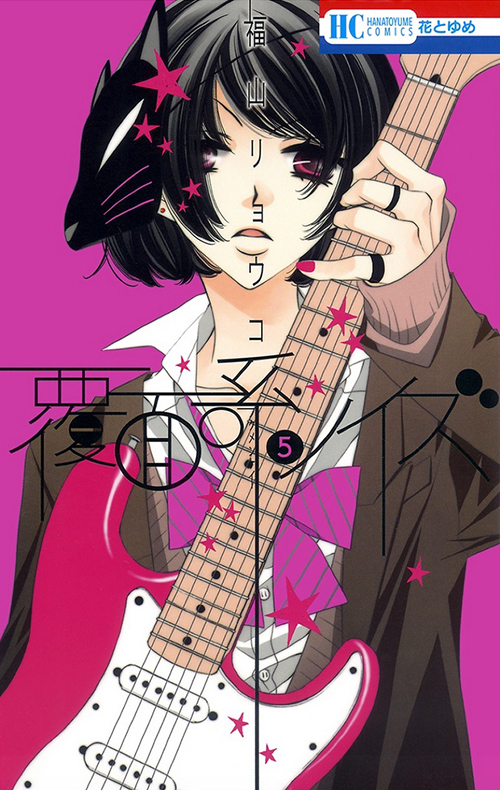 Momo and Yuzu both have complicated relationships with their mothers which is something we only realize bit by bit through hints dropped in short dialogues and backflashes. There are some really cute childhood scenes, especially for Yuzu and Nino. The scenes of their meetings at the beautiful shore of Yuigahama, when they’re kids and then later after they’ve met again, are really powerful. But there are comic elements too, with the constant joke being Yuzu and his omnipresent carton of milk because he’s quite vertically challenged and would love to be taller. We get slapstick elements, some fighting and bickering among the members, some idiosyncratic patterns of behaviour and speech from certain members, like Haruyoshi who refers to himself as atashi, a pronoun reserved for females, and uses a lot of female speech patterns because he grew up with 6 sisters :) And one thing I love is the portrayal of the friendship between the two Inohari girls, Nino and Miou, despite the fact that it’s Nino who gets all that attention from Miou’s crush Yuzu. (I shall forever worship at the shrine dedicated to Miou while everyone else is deciding whether they’re Team Momo or Team Yuzu ;) There’s also a cast of more or less charming minor characters, the Kuroneko band members, other artists and models they work with, the managers and producers, journalists and some fans who serve to shed light on the bands’ stories from their respective perspective, but they always remain somewhat sidelined in the presence of the triangle Nino-Momo-Yuzu.
Momo and Yuzu both have complicated relationships with their mothers which is something we only realize bit by bit through hints dropped in short dialogues and backflashes. There are some really cute childhood scenes, especially for Yuzu and Nino. The scenes of their meetings at the beautiful shore of Yuigahama, when they’re kids and then later after they’ve met again, are really powerful. But there are comic elements too, with the constant joke being Yuzu and his omnipresent carton of milk because he’s quite vertically challenged and would love to be taller. We get slapstick elements, some fighting and bickering among the members, some idiosyncratic patterns of behaviour and speech from certain members, like Haruyoshi who refers to himself as atashi, a pronoun reserved for females, and uses a lot of female speech patterns because he grew up with 6 sisters :) And one thing I love is the portrayal of the friendship between the two Inohari girls, Nino and Miou, despite the fact that it’s Nino who gets all that attention from Miou’s crush Yuzu. (I shall forever worship at the shrine dedicated to Miou while everyone else is deciding whether they’re Team Momo or Team Yuzu ;) There’s also a cast of more or less charming minor characters, the Kuroneko band members, other artists and models they work with, the managers and producers, journalists and some fans who serve to shed light on the bands’ stories from their respective perspective, but they always remain somewhat sidelined in the presence of the triangle Nino-Momo-Yuzu.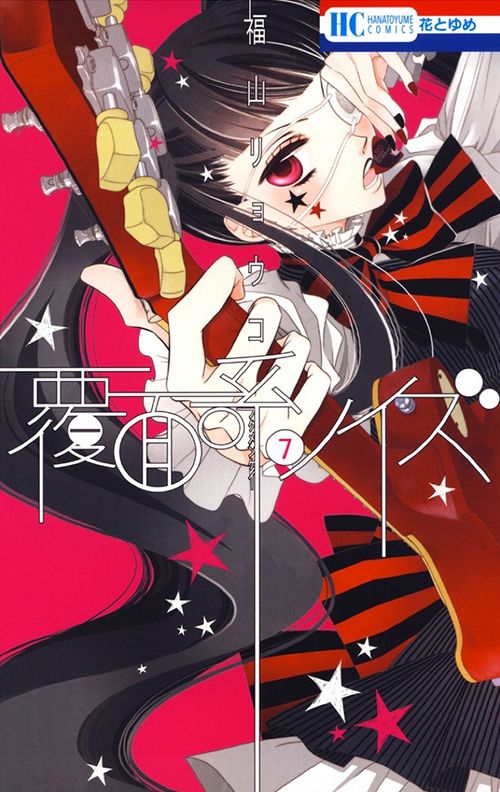 Fukumenkei refers to the fact that both Inohari and Kuroneko use masks, eye-patches and bandages to hide their true identities; this gives them very unique looks, one might say they look slightly visual-kei, with a gothic lolita-inspired Alice. Fukuyama’s forte as a mangaka are definitely her illustrations, especially the ones in color. (In that respect, it’s a real loss for the charms of the series that most of the color illustrations are printed just black and white in the tankÅbon versions and can only be fully enjoyed by magazine readers until an artbook is released.) These images match the aesthetics used for ‘real’ albums covers, concert posters, ads and magazine spreads perfectly, giving readers the chance to follow Inohari almost like a band that exists in real life. This experience will now become only stronger with
Fukumenkei refers to the fact that both Inohari and Kuroneko use masks, eye-patches and bandages to hide their true identities; this gives them very unique looks, one might say they look slightly visual-kei, with a gothic lolita-inspired Alice. Fukuyama’s forte as a mangaka are definitely her illustrations, especially the ones in color. (In that respect, it’s a real loss for the charms of the series that most of the color illustrations are printed just black and white in the tankÅbon versions and can only be fully enjoyed by magazine readers until an artbook is released.) These images match the aesthetics used for ‘real’ albums covers, concert posters, ads and magazine spreads perfectly, giving readers the chance to follow Inohari almost like a band that exists in real life. This experience will now become only stronger with 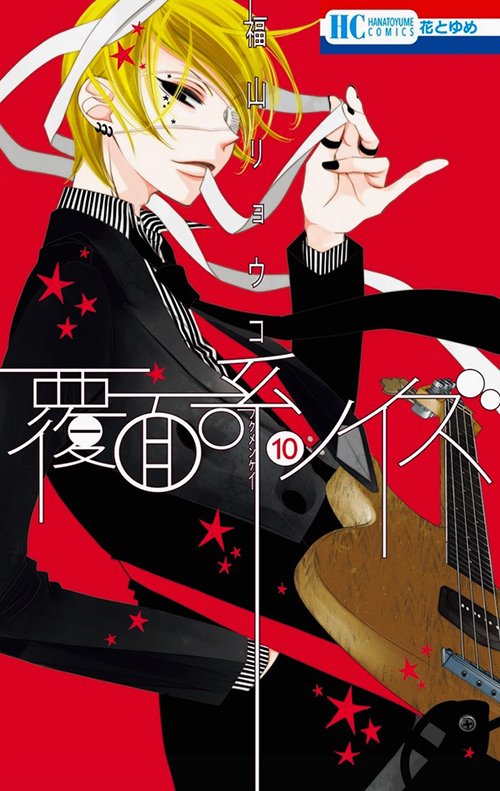 Fukumenkei Noise has the ability to captivate a wide readership, both female and male, despite being a shÅjo manga title. It might be similar to another HanaYume series in that respect, i.e. Takaya Natsuki’s Fruits Basket which was also able to reach even more people after it received its anime adaptation and it remains to be seen if Fukumenkei Noise can manage the same. And you cannot help but feel that Fukumenkei Noise also pays homage to the cult classic, the iconic, the one and only music and romance manga for girls by Yazawa Ai – the unfinished NANA! With the genre and a heroine called Nino which isn’t all that far from Nana, the shared name of the two heroines of Yazawa’s hit series, Fukumenkei Noise has been predestined for comparisons with the former. And it is definitely not wrong to call Fukumenkei Noise a NANA for middle schoolers, targeting mainly 13 or 14-year old girls, unlike NANA with its slightly older fan demographic. Fukumenkei Noise is fun, energetic and eye-catching but it sometimes lacks the depth and emotional scope of NANA as it never looks for too long into the abyss of desperation the way Yazawa’s unfinished masterpiece does.
Fukumenkei Noise has the ability to captivate a wide readership, both female and male, despite being a shÅjo manga title. It might be similar to another HanaYume series in that respect, i.e. Takaya Natsuki’s Fruits Basket which was also able to reach even more people after it received its anime adaptation and it remains to be seen if Fukumenkei Noise can manage the same. And you cannot help but feel that Fukumenkei Noise also pays homage to the cult classic, the iconic, the one and only music and romance manga for girls by Yazawa Ai – the unfinished NANA! With the genre and a heroine called Nino which isn’t all that far from Nana, the shared name of the two heroines of Yazawa’s hit series, Fukumenkei Noise has been predestined for comparisons with the former. And it is definitely not wrong to call Fukumenkei Noise a NANA for middle schoolers, targeting mainly 13 or 14-year old girls, unlike NANA with its slightly older fan demographic. Fukumenkei Noise is fun, energetic and eye-catching but it sometimes lacks the depth and emotional scope of NANA as it never looks for too long into the abyss of desperation the way Yazawa’s unfinished masterpiece does.